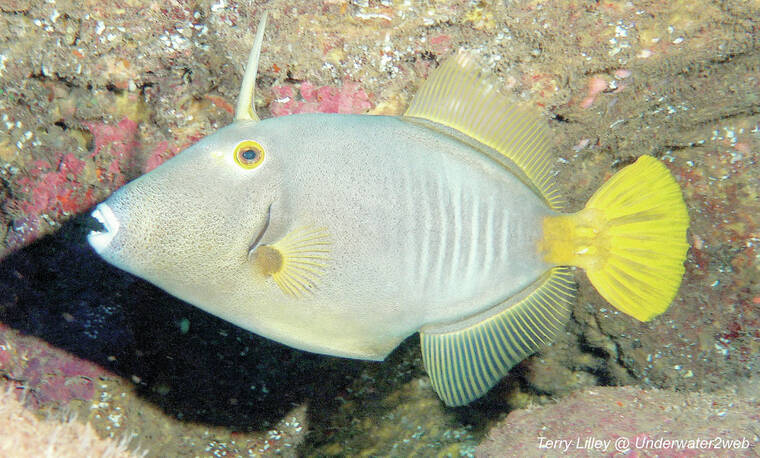This gold, 14-inch-long fish is one critter you do not want to mess with! It has fused, very-sharp teeth, and can bite off an entire chunk of the reef or live coral for food. They are called file-fish because their skin and tiny, rough scales are like sandpaper. Even sharks and moray eels have a hard time biting into them.
This gold, 14-inch-long fish is one critter you do not want to mess with! It has fused, very-sharp teeth, and can bite off an entire chunk of the reef or live coral for food. They are called file-fish because their skin and tiny, rough scales are like sandpaper. Even sharks and moray eels have a hard time biting into them.
Their jaws are so strong that when they sleep on the reef at night time they bite down on the reef or a live coral and lock their jaws in place so they can’t be removed. I have seen several of these fish locked onto the reef at night in a small cave, and it looked like a file-fish parking garage! Their jaws are like a pair of vice grips, and they can easily bite off someone’s finger if you get in the way of their feeding. They normally ignore divers, but one should not try to catch one.
The barred file-fish have a dorsal spine that becomes erect when they are threatened. This spine can also help them lock into a cave or crack so they cannot be pulled out backwards.
Their Hawaiian name “‘o‘ili” means “to sprout,” as the spine comes up out of a groove in their back and looks like it grows upwards. Our Hawaiian trigger-fish also have a similar dorsal spine, but they have two spines, and file-fish only have one spine. Sound travels better underwater than in the air, and you can hear these fish feeding on the reef sometimes from 30 feet away as they bite off chunks of solid rock to digest the algae growing on the reef. You often see them traveling in pairs, but what is so mysterious is you never see any of their babies or young. The juveniles have white spots on their brown skin, and I have seen a few of them, but I have never seen a baby! Sometimes our reef fish go into deeper water to lay eggs where we can’t go as scuba divers, so someday I hope to see a baby ‘o‘ili to see what they look like. You can see the barred file-fish in action in my new movie called “Maui Scuba Diving and Marine Life” on my YouTube channel at Underwater2web.
•••
Terry Lilley is a marine biologist living in Hanalei. He is co-founder of Reef Guardians Hawai‘i, a nonprofit on a mission to provide education and resources to protect the coral reef. To donate to Reef Guardians Hawaii go to www.reefguardianshawaii.org.



